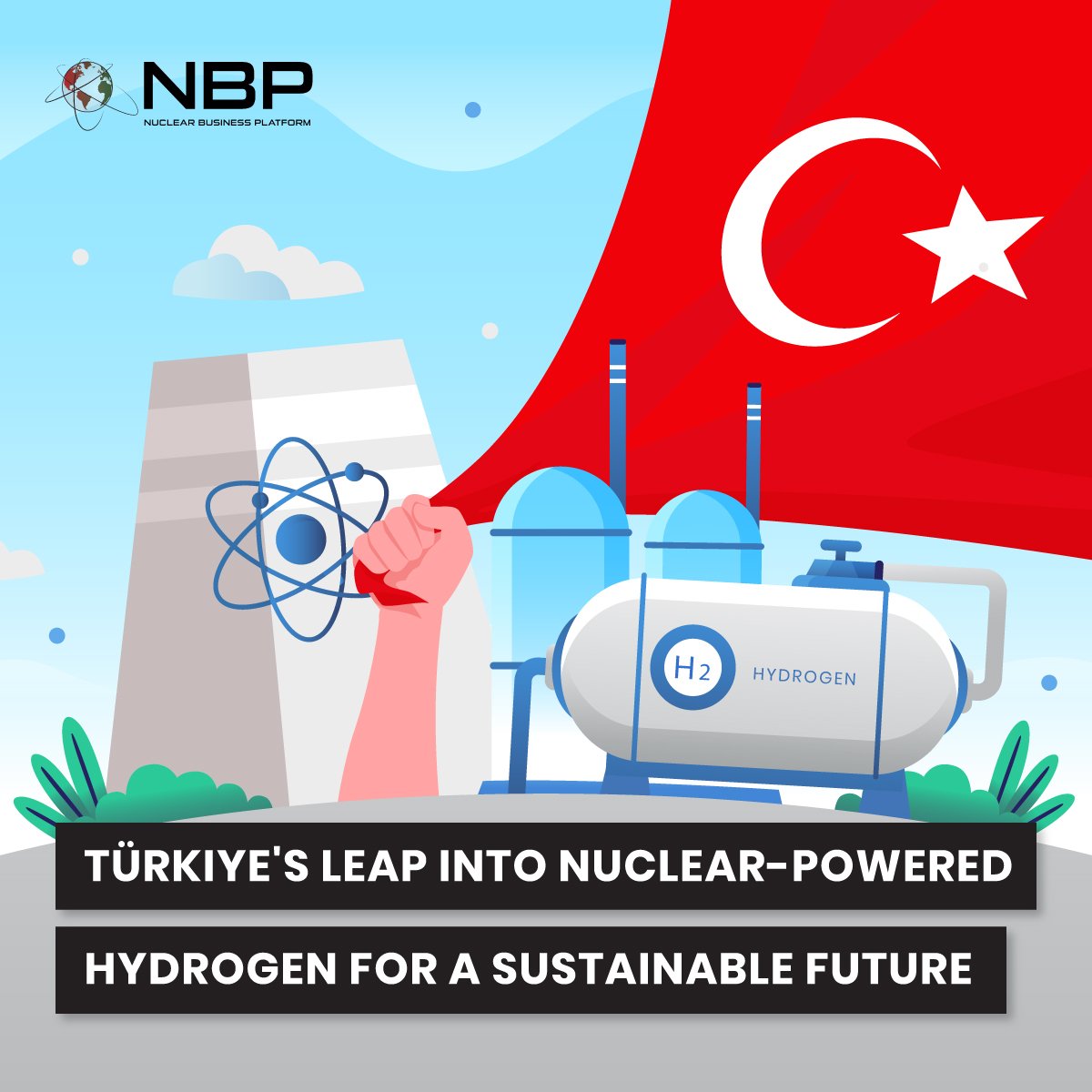Türkiye's Leap into Nuclear-Powered Hydrogen for a Sustainable Future
In the ever-evolving landscape of global hydrogen demand, the role of nuclear energy has emerged as a strategic imperative for sustainable and low-emission production. In 2022, up until the present time, the world witnesses a surge in hydrogen use, projecting an upward trajectory driven by industry, refining, and transport. This article delves into the innovative initiatives of TENMAK (Turkish Energy, Nuclear and Mining Research Institute), particularly its ambitious targets for green hydrogen production, and sheds light on the pivotal integration of nuclear energy in Türkiye's energy strategy. With heightened awareness of the environmental costs associated with hydrogen production, the nuclear-powered hydrogen paradigm becomes a focal point for ushering in a cleaner and more efficient era.
The Global Hydrogen Demand
As of 2022, global hydrogen use has surged to 95 million tonnes (Mt), projected to reach 155 Mt by 2030, driven by industry, refining, and transport. China leads with 29% of global consumption, followed by North America at 17%. Hydrogen production hit 95 Mt in 2022, a 3% rise from the previous year, but at an environmental cost—emitting around 900 million tonnes of CO2. Despite increased production, low-emission hydrogen remains minimal, accounting for less than 1 Mt in 2022, a mere 0.7% of global production. The challenge lies in balancing demand growth with sustainable, low-emission production.
The hype around green hydrogen is noticeable, with proponents viewing it as a game-changer in the fight against climate change. It’s seen as a key tool in achieving a net-zero world, transforming heavy-polluting industries, and even entering our daily lives in the form of hydrogen fuel cell vehicles. The European Union (EU) has put forward a comprehensive framework to support the uptake of renewable and low-carbon hydrogen. It aims to produce 10 million tonnes and import an equal amount by 2030. Germany, on the other hand, has adopted a National Hydrogen Strategy to promote the use of this climate-friendly gas. They aim to increase green hydrogen production capacity to at least 10 gigawatts by 2030. China has more than 30 projects involving “green” hydrogen since 2019 and recognizes hydrogen as one of the six industries of the future. These initiatives underscore the global commitment to harnessing the potential of green hydrogen for a sustainable future.
TENMAK’S Targets for Green Hydrogen Production
TENMAK's (Turkish Energy, Nuclear and Mining Research Institute) primary focus from 2023 to 2053 centers on advancing green hydrogen and associated electrolyzer technology. Beginning with a 500 kW electrolyzer in 2023, the trajectory aims for an ambitious 500 MW to 1 GW electrolyzer by 2053. This journey involves creating domestic biomass gasification demo systems, biogas pyrolysis systems, advanced biological/microbial hydrogen production tech, and innovative bioreactor designs. Initiatives target substantial hydrogen production, exceeding 15m³ H2/day with reactors surpassing 10m³ in capacity.
Complementing this, TENMAK commits to hydrogen utilization technology development, from a 10 kW fuel cell to a 300 kW fuel cell by 2053. These fuel cells are earmarked for deployment in land vehicles, marine vessels, railways, and aircraft.
For sustainable energy, TENMAK sets ambitious targets for green hydrogen production competitiveness and scale. Aiming to reduce production costs significantly, targeting below US$2.4/kgH₂ by 2035 and an even more ambitious goal of US$1.2/kgH₂ by 2053. Simultaneously, TENMAK envisions substantial electrolyzer growth, targeting 2 GW in 2030, 5 GW in 2035, and an impressive 70 GW in 2053.
Nuclear Power's Role in Hydrogen Production: A Strategic Imperative
Integral to Türkiye's energy strategy is the incorporation of nuclear power as a primary catalyst for hydrogen production. By 2035, the aim is to establish a nuclear power plant capacity of 7.2 GW, a significant contributor to the targeted 5 GW electrolyzer installed power. This nuclear-driven electrolysis is expected to yield approximately 625,000 tonnes of hydrogen annually, a crucial milestone in Türkiye's hydrogen production objectives.
To meet the 5 GW electrolyzer installed power target by 2035, corresponding to an annual hydrogen production of 625,000 tonnes, Türkiye envisions a nuclear power plant capacity of around 4 GW. Looking ahead to 2053, with an ambitious goal of 70 GW electrolyzer installed power and hydrogen production reaching 8.75 million tonnes, the projected nuclear power plant capacity is approximately 56 GW. This strategic integration of nuclear power and hydrogen production showcases Türkiye's forward-thinking approach to meeting the escalating demand for clean hydrogen, positioning nuclear energy as a pivotal element in its future energy landscape.
Nuclear power plants emerge as a formidable option for generating low-carbon hydrogen, with the innovative concept of small modular reactors dedicated solely to hydrogen production providing an additional solution. The potential introduction of Hydrogen Valleys equipped with small modular reactors stands as a promising avenue for the near future. Research and development efforts focused on high-temperature electrolyzers remain crucial for advancing hydrogen production technologies. Recognizing the symbiotic relationship between renewable energy sources and nuclear energy, their collaborative utilization becomes imperative for realizing the vision of low-carbon hydrogen.
Interest in nuclear hydrogen production is on the rise globally, driven by nuclear energy's capacity to provide power and heat for hydrogen production in a feasible, low-carbon, and economical manner. A single 1000 MW nuclear reactor could potentially produce over 200,000 tons of hydrogen annually. Nations with existing nuclear facilities have a unique advantage in incorporating nuclear energy into their hydrogen initiatives.
Nuclear energy is ideally situated for generating zero-carbon hydrogen, a novel energy carrier with many uses, as it operates at extremely high capacity factors. The following are the improvements that nuclear energy has made to its role in producing green hydrogen during the last 10 to 20 years:
Cold electrolysis of water utilizing off-peak capacity (requires 50–55 kWh/kg).
Low-temperature steam electrolysis using nuclear reactor heat and energy.
High-temperature thermochemical production utilizing nuclear heat.
High-temperature steam electrolysis using nuclear heat and electricity
Nuclear-Powered Hydrogen Production
Within the realm of hydrogen production, nuclear energy emerges as a formidable and versatile ally, providing the foundation for distinct methodologies, each represented by a distinctive hue in the hydrogen color spectrum.
Pink Hydrogen: At the forefront is pink hydrogen, a product of electrolysis wherein water is split using electricity generated by a nuclear power plant. This method operates at low temperatures, relying on the infusion of nuclear-generated electricity to facilitate the electrolysis process. Pink hydrogen showcases a commitment to harnessing nuclear power for sustainable hydrogen production while maintaining a focus on efficiency at lower temperature ranges.
Red Hydrogen: Red hydrogen marks a departure into high-temperature thermolysis, where water is catalytically split leveraging nuclear power thermal as a primary energy source. This method, operating at elevated temperatures, capitalizes on the thermal energy derived from nuclear processes to drive the thermolysis of water. Red hydrogen, characterized by its reliance on high temperatures, underscores the potential for nuclear energy to serve as a heat source for efficient hydrogen production.
Purple Hydrogen: The realm of nuclear-powered hydrogen production reaches its zenith with purple hydrogen, a synthesis of electricity and heat obtained from nuclear power. Purple hydrogen is realized through a process known as combined chemo-thermal electrolysis, where both electrical energy and heat derived from nuclear sources contribute to the splitting of water. This sophisticated method operates at high temperatures, highlighting the fusion of electrolysis and thermolysis techniques. Purple hydrogen stands as a testament to the intricate synergy achievable through the integration of nuclear power for comprehensive and high-efficiency hydrogen production.
Current Nuclear Energy Programs for Green Hydrogen Production in the World
The Hydrogen Council reports 359 large-scale nuclear hydrogen projects globally, with over 80% in Europe and Asia. Europe leads with 50% of projects and an expected expenditure of $130 billion, while over 30 nations have explicit nuclear hydrogen programs.
The Nine Mile Point Nuclear Power Station, situated in Oswego, New York, has embarked on a groundbreaking initiative by implementing a low-temperature electrolysis system. Distinguished as the inaugural nuclear-powered clean hydrogen production facility in the United States, this project represents a noteworthy step towards the convergence of nuclear energy and hydrogen technologies. The produced hydrogen serves a dual purpose, not only contributing to the plant's clean energy portfolio but also playing a crucial role in the cooling processes. Constellation, the driving force behind this venture, successfully commenced hydrogen generation in February 2023, marking a milestone in the integration of nuclear power and hydrogen production.
The Davis–Besse Nuclear Power Station, located in Oak Harbor, Ohio, is pioneering a low-temperature electrolysis system aimed at showcasing the technical feasibility and economic benefits of clean hydrogen production. With the overarching objective of paving the way for future large-scale commercialization, this project positions itself as a crucial testing ground for the viability of clean hydrogen within the nuclear energy landscape. The single-unit reactor at Davis–Besse is poised to commence clean hydrogen production by the year 2023, contributing valuable insights to the potential scalability and broader applications of this innovative approach.
The Prairie Island Nuclear Generating Plant, situated in Red Wing, Minnesota, is adopting a high-temperature electrolysis system to advance clean hydrogen production. Beyond immediate hydrogen generation, this project holds strategic significance as the data gathered from the demonstration will inform future endeavors aimed at scaling up this process. Anticipated to commence hydrogen production in early 2024, the Prairie Island Nuclear Generating Plant contributes to the evolving landscape of clean energy solutions, emphasizing the importance of integrating high-temperature electrolysis within nuclear power operations.
In conclusion, the symbiotic relationship between nuclear energy and hydrogen production is poised to revolutionize the global energy landscape. The commitment of nations, exemplified by Türkiye's strategic integration, showcases a pioneering approach to meet the escalating demand for clean hydrogen. As demonstrated by groundbreaking projects in the United States, the intersection of nuclear power and hydrogen production holds the key to unlocking a future where low-carbon hydrogen is not just a goal but a reality. With numerous nations worldwide investing in large-scale nuclear hydrogen projects, the potential for nuclear energy to drive a sustainable hydrogen revolution is clearer than ever, offering a glimpse into a greener and more efficient energy future.




